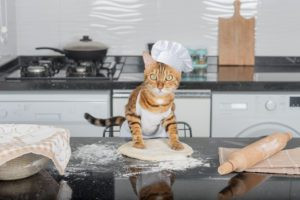Cats are enigmatic creatures, known for their subtle communication and unique behaviors. Among these fascinating feline quirks is kneading, often affectionately referred to as “making biscuits.” This endearing action involves your cat rhythmically pushing their paws into a soft surface, alternating between left and right, much like a baker kneading dough. But what exactly drives this behavior? Let’s delve into the various reasons behind why cats make biscuits.
 A tabby cat gently kneading a soft blanket, demonstrating the common "cats making biscuits" behavior with their paws.
A tabby cat gently kneading a soft blanket, demonstrating the common "cats making biscuits" behavior with their paws.
Understanding the Biscuit-Making Behavior
Cat biscuit making, or kneading, is characterized by the repetitive pushing and pulling of their front paws, often accompanied by a gentle purr and a look of contentment. They might knead on blankets, soft furniture, or even on you! This action can seem puzzling at first, but it’s a perfectly normal and instinctive feline behavior rooted in a variety of factors, from kittenhood memories to marking their territory. When you witness your feline friend engaged in this activity, it’s like watching a miniature, furry baker at work, meticulously preparing a batch of imaginary biscuits.
The Kittenhood Connection: Nursing Instincts
One of the primary reasons cats make biscuits stems from their earliest experiences as kittens. When nursing, kittens instinctively knead around their mother’s mammary glands. This kneading action, also known as “milk treading,” stimulates milk flow, ensuring they get the nourishment they need. This association of kneading with comfort, warmth, and sustenance is deeply ingrained in their memory.
As cats mature, this behavior often persists, becoming a comforting and self-soothing action. Even when they are no longer nursing, the rhythmic motion of kneading evokes those early feelings of security and contentment associated with their mother’s care. It’s a behavior that has been carried over from kittenhood into adulthood, acting as a nostalgic link to a time of complete dependence and comfort.
Comfort, Happiness, and Affection
Beyond the purely instinctual reasons, cats often make biscuits when they are feeling happy, secure, and content. If your cat is kneading on you while you are petting them, consider it a high compliment! This is their way of reciprocating affection and expressing their comfort and joy in your presence. The act of kneading releases endorphins in their brains, creating a pleasurable sensation that reinforces positive associations with their surroundings and companions.
It’s been observed that cats who are particularly bonded with their owners might knead more intensely. The harder they knead, the greater their level of affection and comfort they are expressing towards you. While this can sometimes be a bit pinchy if their claws are out, it’s important to remember it’s a sign of deep affection. Keeping your cat’s nails trimmed can ensure these biscuit-making sessions remain enjoyable for both of you.
Nesting and Preparation for Comfort
Another reason cats make biscuits is related to their innate nesting instincts. In the wild, felines would pat down grass and leaves to create a comfortable and safe sleeping or resting area. Domestic cats retain this behavior, and you might observe them kneading their bedding, blankets, or favorite napping spots before settling down. They are essentially mimicking their wild ancestors, preparing a soft and comfortable “nest” for themselves.
This kneading action is not just about physical comfort; it also serves a psychological purpose. By kneading their chosen spot, they are making it feel more familiar and secure, creating a haven where they can relax and feel safe. It’s a way for them to personalize their environment and make it truly their own.
Relaxation and Stress Relief
Cats are masters of relaxation, and biscuit making can be a key part of their unwinding ritual. When a cat is kneading, especially if accompanied by purring and slow blinking, it’s a strong indicator that they are in a state of deep relaxation. You might notice this behavior when they are snuggled up in a cozy spot, such as your lap or a soft bed. In these moments, kneading can be a prelude to a peaceful catnap or a long, restful sleep.
For some cats, kneading can also serve as a form of stress relief. The repetitive, rhythmic motion can be soothing and calming, helping them to alleviate anxiety or tension. Observing your cat making biscuits can be a valuable insight into their emotional state, letting you know when they are feeling particularly content or seeking comfort.
Scent Marking and Territory
Cats are territorial animals, and scent marking is a crucial part of their communication. They have scent glands located in their paws, among other places like their cheeks and head. When a cat makes biscuits, they are not only enjoying the physical sensation but also depositing their scent onto the surface they are kneading. This scent marking serves as a message to other cats, claiming ownership of that particular area or object.
When your cat kneads on you, they might be subtly (or not so subtly!) declaring you as “theirs” to other felines in the household. This is a sign of trust and comfort, as they are including you within their scent territory. Whether it’s on bedding, toys, or their beloved human, biscuit making is often accompanied by this important act of scent communication.
Stretching and Muscle Activation
Beyond the emotional and instinctual reasons, there’s a more practical aspect to why cats make biscuits – stretching. Just like humans, cats need to stretch their muscles, especially after periods of inactivity. The kneading motion allows them to extend their arms and paws, improving circulation and relieving stiffness. This is particularly beneficial after they have been curled up for a nap or resting for a while.
Stretching is essential for maintaining a cat’s agility and flexibility. Biscuit making provides a gentle and natural way for them to keep their muscles active and ready for action, whether that’s chasing a toy or leaping onto a high shelf. So, while it might look like they are baking up a storm, they are also engaging in a beneficial physical activity.
Hormonal Signals: Heat and Labor
In female cats, kneading can also be linked to hormonal changes, specifically when they are in heat or going into labor. A female cat in heat might knead while lying on her side, often accompanied by purring and stretching. This behavior is part of their way of signaling to potential mates that they are receptive to mating. They may also exhibit other signs like increased vocalization and spraying.
Similarly, kneading can be observed in pregnant cats as they approach labor. They may knead their bedding intensely as part of their nesting behavior, preparing a comfortable space for their kittens to arrive. If you notice a pregnant cat kneading extensively, especially if she was recently in heat and has a noticeably enlarged abdomen, it could be a sign that labor is imminent.
Conclusion: Biscuit Making is a Language of Love and Comfort
In conclusion, the endearing behavior of Cats Making Biscuits is a multifaceted phenomenon rooted in instinct, emotion, and communication. From the comforting memories of kittenhood nursing to expressing happiness, marking territory, and even stretching their muscles, there are numerous reasons why cats engage in this rhythmic pawing.
Understanding why cats make biscuits allows us to appreciate this behavior even more. It’s a window into their emotional world, a way for them to communicate comfort, affection, and contentment. So, the next time you see your feline companion kneading away, remember that they are likely expressing a range of feelings, all wrapped up in this charming and uniquely feline action. And while they might not be actually baking biscuits, they are certainly serving up a generous helping of feline affection.

